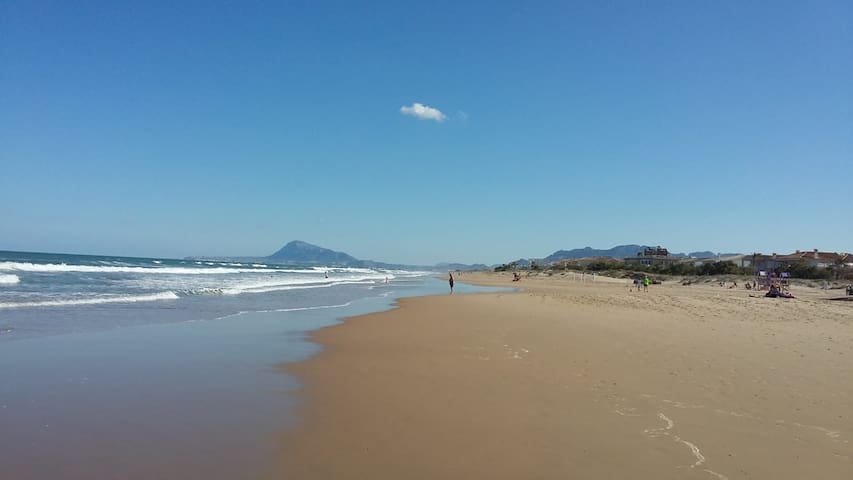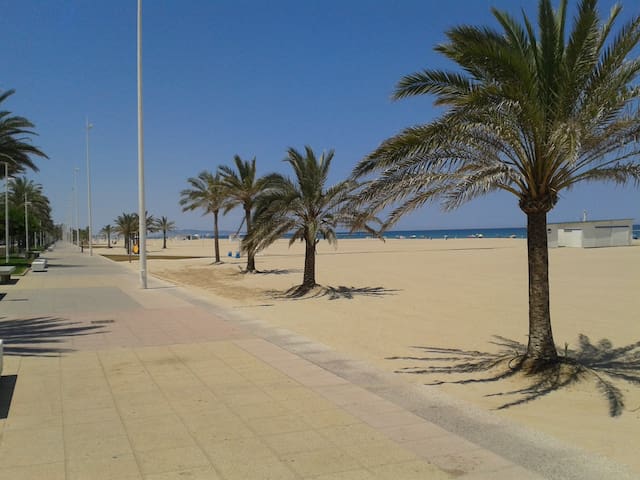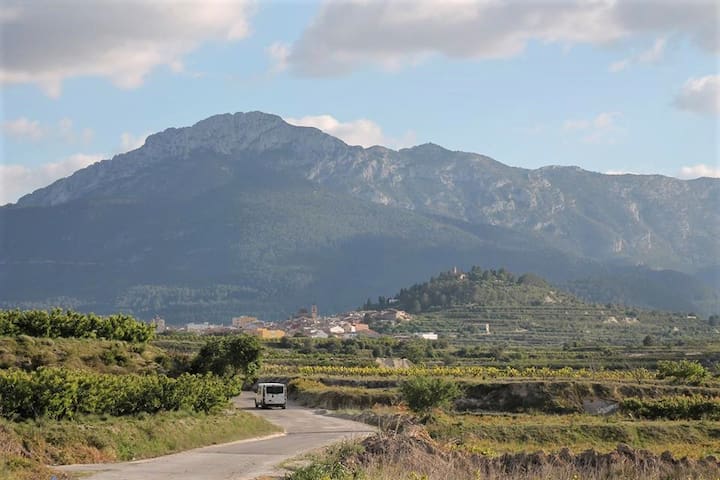Bars and restaurants in Castello de Rugat
There are some simple bars and restaurants in the village, but not all of them serve food. Those that do are mainly focussed on serving workers so the food tends to be wholesome and good value dishes rather than anything fancy. There is also only a limited choice of dishes. However, given that they are offering a 3-course lunch, which includes a glass of wine or beer, for 15€ or less it is difficult to cook a meal at home for the same cost. Plus of course there is no need to shop, cook or clean up. 😊
Be aware that places to eat in the evening are very limited.
The choices are:
• Cafeteria Pa Artesa Osbel - Carrer de Sant Vincent 27 (part of the bakery). Open only in the mornings for light breakfast snacks and coffee, but very popular. They have some tables outside when the weather is nice.
- Angelo's Pizza - C/ Joan Martorell n.7 - Open Thursday evening to Sunday evenings only. Probably the most popular place to eat with guests, but that may be because it is so close to the house.
They mainly serve pizza but usually on Friday’s & Saturdays there is other food on offer including grilled meats. (Please check before if that is important to you). You can also order pizza to take away.
We really like their salads, and usually order 1 to share between 2 or 3 people. They let you choose whether to order ½ a pizza or a whole pizza – be warned you should only need ½ a pizza each - especially if you are having a starter or salad.
- Bar Restaurante El Raconet de Maite - Av. De Cami Real 154 (next to the BP garage) - Popular for drinks and food all day and into the evening. Outside seating available.
They are open for breakfast from 6.00 am which is very popular, especially at the weekend, but we are never up that early. During the week they serve ‘menú del día’ at lunchtime and tapas and other food in the evening.
Note - for paella you have to go and order it the day before but it is worth it.
Also - there is no food available on Sunday evenings.
- Genesis Restaurant, Cami de Salem 21 - Also open all day, from breakfast and serving a ‘menu del dia’. Food is not served every evening so please check with the restaurant. It closes at 16.00 on Mondays. The separate, large restaurant section is located through a door at the rear of the bar. The outside seating is for drinks only.
• Bar Avenida - Av. del Cami Real 42 - popular for breakfast, a simple lunchtime menu del dia and evening drinks. Has a lovely little patio at the back. Closes at 16.00 on Mondays and 22.00 Tuesdays – Thursdays, later at the weekend.
- Tic Tac Pub - Carrer de la Font 45 - Bar/pub for evening drinks. Open until late. Large patio at the
back. No food served. Has table/bar football and a pool table.
- L'Unic Pub - Carrer de la Font 47 - Another bar for the evenings. Open late. Large patio at the back. They sometimes have music and events. No food served. Closed Monday and Tuesday.
- Social Club – this is the closest venue to the holiday rental for a drink. It is popular during the day for drinks and coffee. They sometimes also do food but it is mainly focussed on ‘more mature’ customers.
If you want to go out just for a drink in the evening, this bar is where we head to. It has a beer garden at the back and a pool table and bar football and opens late.
Tic-Tac
45 Carrer de la FontIf you want to go out just for a drink in the evening, this bar is where we head to. It has a beer garden at the back and a pool table and bar football and opens late.
Local beaches
We would highly recommend a visit to Oliva’s soft sandy beaches with their gently sloping seabed. Each part of the beach has a different feel ranging from the sand dunes in the north, to the area in the south which is very popular with kiteboarders and windsurfers.
Platja de Pau Pi
Carrer de la Mare de Déu del MarWe would highly recommend a visit to Oliva’s soft sandy beaches with their gently sloping seabed. Each part of the beach has a different feel ranging from the sand dunes in the north, to the area in the south which is very popular with kiteboarders and windsurfers.
If you want to spend time in a lively holiday location, visit Gandia beach and the surrounding area in summer.
The miles of stunning, soft, sandy beaches, with their blue flag status are what draw most summer visitors. The beachfront boasts a beautiful long promenade with lots of restaurants, hotels, shops, bars, and clubs plus in the summer, Chirinquitos (beach bars) on the sand.
10 locals recommend
Gandia Beach
23-25 Ronda de VeneciaIf you want to spend time in a lively holiday location, visit Gandia beach and the surrounding area in summer.
The miles of stunning, soft, sandy beaches, with their blue flag status are what draw most summer visitors. The beachfront boasts a beautiful long promenade with lots of restaurants, hotels, shops, bars, and clubs plus in the summer, Chirinquitos (beach bars) on the sand.
Local walks
One of our favourite walks in the area is to climb the mountain of Sierra del Benicadell. At 1,104 metres, it’s not too high, and has a well-maintained path for most of the way. The views from the top are spectacular and you can often sit and watch eagles flying beneath you.
Apart from in the heat of the summer, the walk up is is easily achievable for anyone with a reasonable fitness level. Only the very last section, where you have to scramble up across slippery rocks, is difficult and you may want to miss this last section off. (If you plan to attempt the top section, make sure you are wearing shoes with good grippy soles).
Serra del Benicadell
One of our favourite walks in the area is to climb the mountain of Sierra del Benicadell. At 1,104 metres, it’s not too high, and has a well-maintained path for most of the way. The views from the top are spectacular and you can often sit and watch eagles flying beneath you.
Apart from in the heat of the summer, the walk up is is easily achievable for anyone with a reasonable fitness level. Only the very last section, where you have to scramble up across slippery rocks, is difficult and you may want to miss this last section off. (If you plan to attempt the top section, make sure you are wearing shoes with good grippy soles).
City/town information
This beautiful old town, 19 miles inland from Castello de Rugat, was declared a historic-artistic site in 1982 and is a place great explore.
It is best appreciated by taking a leisurely stroll through its streets and squares to admire its wealth of historical buildings. With its many fountains, churches, palaces, spacious avenues and grand old buildings it is easy to imagine yourself transported back in time.
39 locals recommend
Xàtiva
This beautiful old town, 19 miles inland from Castello de Rugat, was declared a historic-artistic site in 1982 and is a place great explore.
It is best appreciated by taking a leisurely stroll through its streets and squares to admire its wealth of historical buildings. With its many fountains, churches, palaces, spacious avenues and grand old buildings it is easy to imagine yourself transported back in time.
Castello dates to the time when the Moors populated this area, and therefore although it is a predominately a practical working village, there are some interesting sights to take in.
Take a stroll round the narrow roads of the old part of the village with it’s ancient houses, some with foundations dating back to the time of the Moors.
A visit to the Ermita which sits on top of a hill on the western edge of the town is a must for every visitor. Its elevated position means it has an excellent viewpoint over much of the valley and to the mountains beyond. On a clear day Xàtiva castle can be seen in the far distance, and you may spot Hoopoe birds and squirrels.
Castelló de Rugat
Castello dates to the time when the Moors populated this area, and therefore although it is a predominately a practical working village, there are some interesting sights to take in.
Take a stroll round the narrow roads of the old part of the village with it’s ancient houses, some with foundations dating back to the time of the Moors.
A visit to the Ermita which sits on top of a hill on the western edge of the town is a must for every visitor. Its elevated position means it has an excellent viewpoint over much of the valley and to the mountains beyond. On a clear day Xàtiva castle can be seen in the far distance, and you may spot Hoopoe birds and squirrels.
City advice
Getting around
A car is essential
Because of its rural location your own transport is essential to get the most out of everything this region has to offer.
There is no public transport in the area, nor a taxi service in town. (There is a very occasional bus service into Gandia hospital, but it runs at the most once a day).
Getting around
Going to Valencia - Go by Train
One occasion we would recommend that you do take the train is if you want to visit Valencia. Driving in the city centre is not for the faint-hearted, the traffic there can be crazy and recently they have restricted many roads to taxis and buses only.
The nearest large train stations to us are in Gandia, Xativa and Xeraco, from these there are frequent trains to the centre of Valencia. There is free parking right outside the station at Xeraco, just north of Gandia which makes it an ideal choice.
There is also a very small station 6 miles away Puebla de Duc.
Ways to save
Lunch = Menu del Dia
The lack of foreign tourists in this region means that the cost of eating out is generally inexpensive. Lunch in particular can be a bargain. In many places you can still get a 3-course lunch, ‘Menu del Dia’ for less than 15€. Often that lunch will include a glass of wine, beer, or a soft drink in the price. The quality of the lunches vary somewhat, but generally they are pretty good, and sometimes exceptional. It is a great, and very affordable, way to try new dishes and foods.
Ways to save
Try a Spanish style Breakfast
Going out for a Spanish style breakfast is a great value meal and a perfect way to start the day. Breakfast usually consists of coffee, a glass of fresh orange juice and a tostado, sometimes with just olive oil, but usually with a tomato topping, and possibly cheese and serrano ham. It is a delicious, filling, and healthy breakfast/brunch which usually costs less than 5€.
(Note all the prices above only apply to places the local Spanish go. The prices in the tourist spots on the coast, especially in places like Moraira, Javea, and of course Valencia and Alicante, are much higher).
Customs and culture
The Two Languages spoken here
There are actually two Spanish languages spoken in this region, Castellano – which is what we typically think of as Spanish, and the local language, Valenciano, which is similar to Catalan. Most locals speak both but use Valenciano as their first language but will generally switch to Castellano for you if you ask. (Although they often forget and switch back).
They are very appreciative of any efforts to speak to them in either language and are always kind and patient, even when we know we are butchering their language.
Customs and culture
Opening Hours & Siesta
You may have heard of the Spanish siesta, but it still can be a surprise to find that most shops and public buildings really do close for siesta. You need to remember to shop in the morning, generally before 1.30pm or leave it until after 4.30-5pm in the evening.
For those that just have to shop in the afternoons, larger supermarkets, chain stores and shopping centres do not observe siesta and stay open all day.
Another big adjustment is that almost every shop, including supermarkets and shopping centres, are closed on Sundays. (Apart from in the big tourist areas).
Customs and culture
Queuing - it is different here but still important
Taking your fair turn is just as important to the Spanish, they just do it in a less obvious manner. Instead of standing formally in a line in Spain they form a virtual queue, and they all know who is next. When you enter a shop or bank, or even if you are waiting to get on a bus, you simply ask ‘who joined last’, and then you know you can take your turn after them. The question to ask is ‘quien es el ultimo? (or if there are only women there, quien es la ultima?). If it is you, the answer is ‘soy el ultimo/soy la ultima
Customs and culture
Parking on the street - which side to park on
Be observant when parking. In most places parking on the street is free but on narrow roads the parking may be legally restricted to just one side of the street. Also, that side may change either monthly or quarterly and on the morning of ‘changeover day’ everyone has to move their car to the other side.
Pay attention therefore to where other cars are parked and any signage in the area. Especially be wary of leaving you car overnight on the last night of the month or quarter if you haven’t checked the signs. It is not pleasant to come back to find that you car has been towed.
Customs and culture
Parking - keep an eye out for temporary restrictions
You will frequently see portable signs standing in the road. These are advising that the road will be closed for a fiesta, race or event. Pay attention to these as they will fine and tow any cars that are not moved in time.
Our Spanish neighbours laughingly tell us the parking tickets for not moving your car in time is a ‘tourist tax’ as they of course know they know the dates of changeover and local fiestas and events.
Customs and culture
Parking in Towns - watch out for when you need to pay
In busy towns there are various parking zones and meters. These are usually indicated by coloured kerbs and lines. Take care to check if you are in a free parking spot or if you need to buy a ticket before parking. Don’t let the meters/pay machines put you off though – on the whole the cost of parking here is pretty low, plus many areas do not charge for parking during siesta time. (Note that you may need to enter your car registration number in the meter - so don't walk down the street to a pay point without knowing it).





